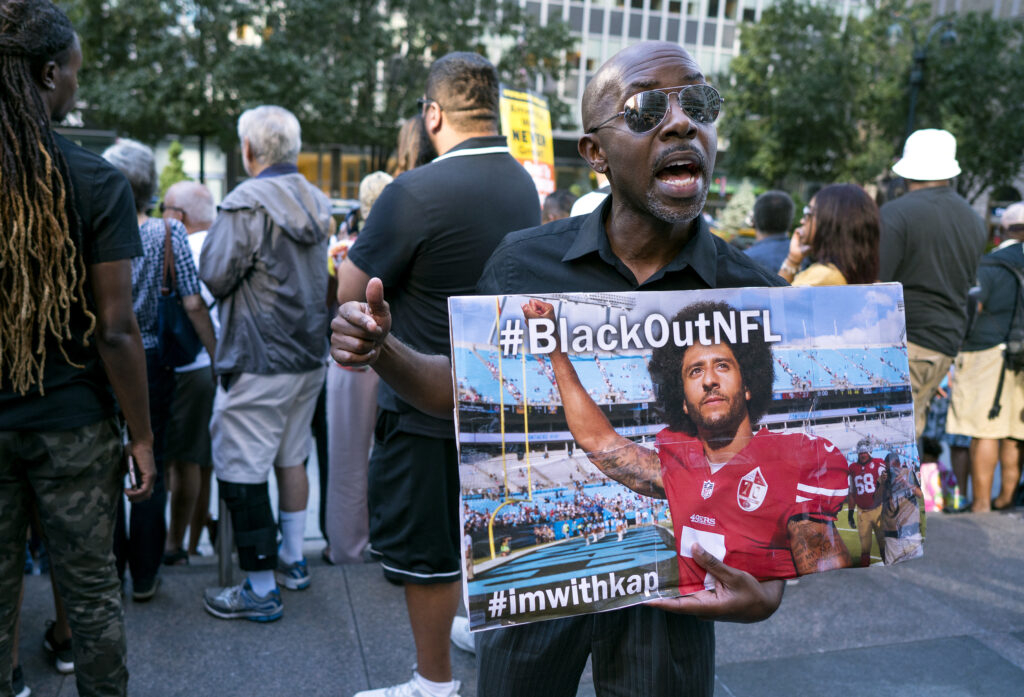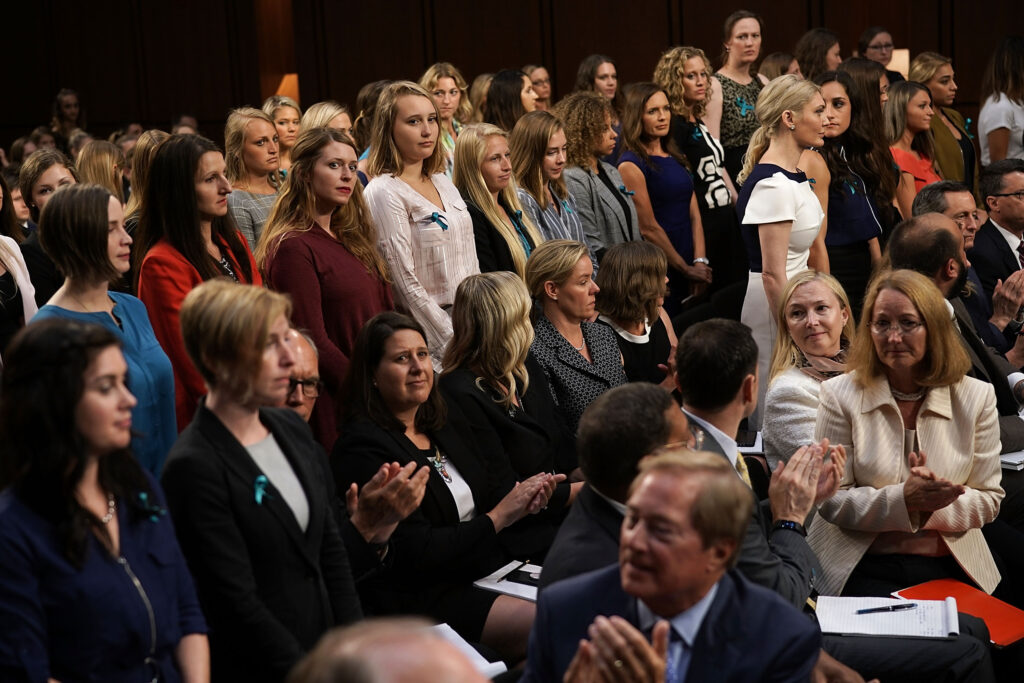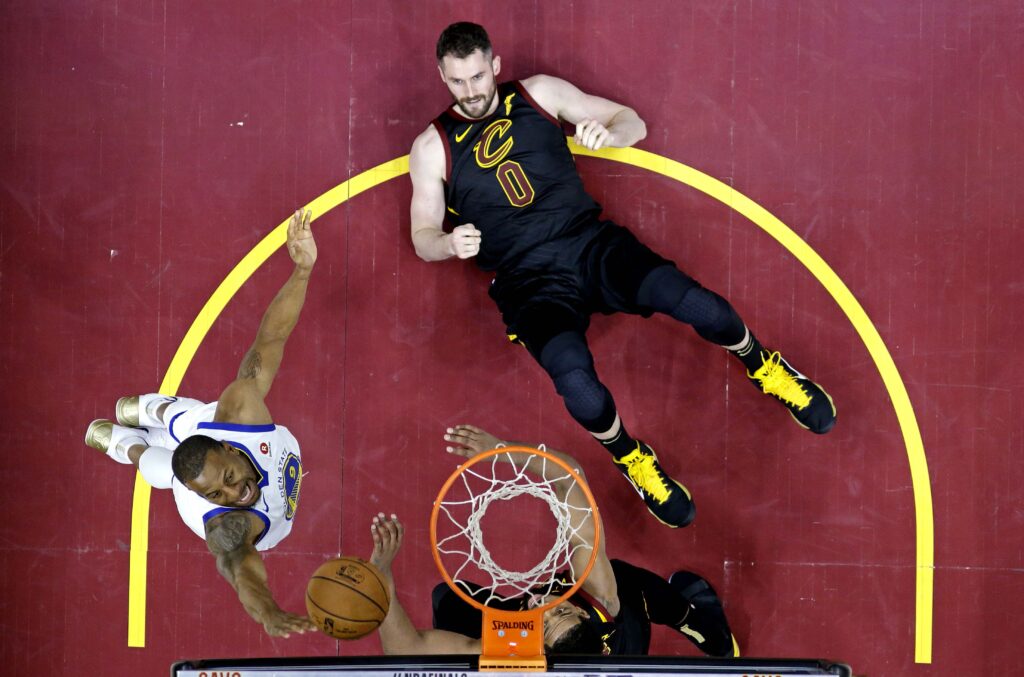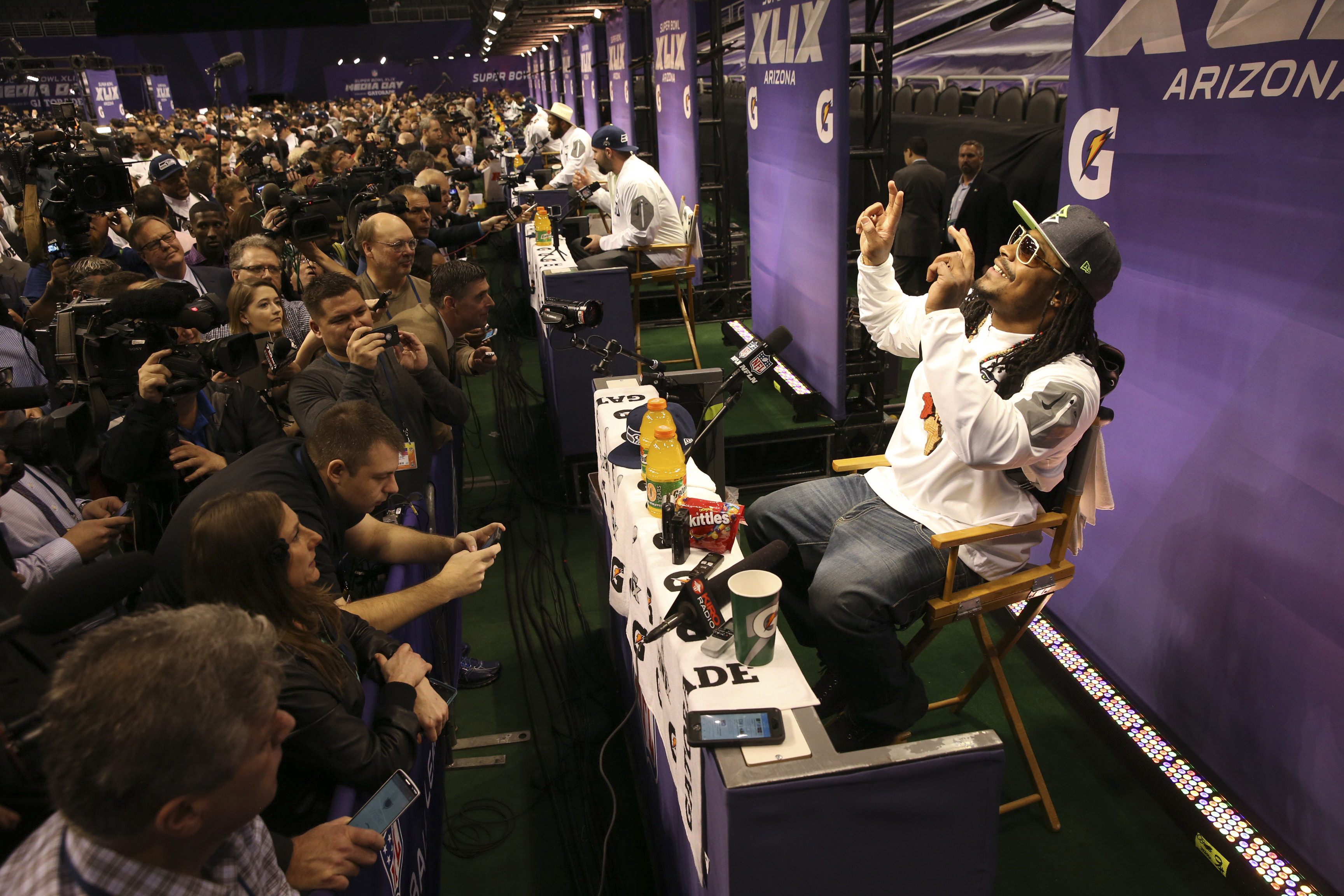When Washington Post sports reporter Kent Babb traveled to Oakland, Calif., to report a feature story on Oakland Raiders running back Marshawn Lynch during the summer of 2017, Babb knew that convincing Lynch to cooperate would be a tough sell.
Lynch, who nicknamed himself “Beast Mode” for his bruising running style, had for years been crafting a public persona built on mystery and mercurial interactions with the mainstream media. At Super Bowl media day in 2015, Lynch, facing a $500,000 fine if he did not make himself available, answered 29 questions in five minutes, all with a variation of “I’m just here so I don’t get fined.” His behavior earned Lynch a loyal following among fans, particularly young ones.
Babb expected Lynch would turn down an interview, even though the story was likely to be a positive-leaning portrayal of Lynch coming out of retirement to play for his hometown Raiders. Babb walked alongside Lynch after a training camp practice with his voice recorder out, hoping to capture any exchange they had. Lynch brushed by him, and that was that.
The Lynch scenario is emblematic of the state of sports journalism today
The terse interaction contrasted sharply with what Babb had witnessed earlier in the day—Lynch being friendly and gregarious with a camera crew from Bleacher Report (B/R).
The San Francisco-based sports site was well aware that few athletes elicited more likes and comments than Lynch, and, for B/R’s mostly millennial and Generation Z audience, nobody seemed as shareable. Bleacher Report’s executives decided he was the right athlete with whom to launch the company into longform documentary production.
Lynch had his choice of platforms. There was The Players’ Tribune, a site founded in 2014 by baseball icon Derek Jeter after his retirement from the New York Yankees. The Players’ Tribune’s staff of editors works with athletes to tell their own stories. Lynch could have joined the long list of athletes who have pitched their stories to Jeter’s young company and gotten compensated once an advertiser jumped onto the pitch as a form of branded content, the main revenue stream for The Players’ Tribune to this point.
Lynch also could have used his personal social media accounts to distribute whatever he wanted to say. With 1.7 million Instagram followers, he could reach more people on his own channel than with The Players’ Tribune, which has fewer than 900,000 combined followers on Twitter and Instagram.
Ultimately, Bleacher Report, with more than 14 million combined followers, won Lynch’s cooperation. “We really wanted to work with Marshawn Lynch,” says Dave Finocchio, B/R’s founder and CEO, “and the great thing about it is he was already a fan of ours. He appreciates that B/R is a little bit more celebratory in nature and has less ‘gotcha’ content on athletes.”
When B/R’s eight-episode “No Script with Marshawn Lynch,” aired in October of last year on Facebook Watch—the social network’s over-the-top streaming distribution channel—Lynch was listed in the closing credits as an executive producer. Bleacher Report replied that it would “not discuss financials” when asked if Lynch had been paid for his involvement.

The Lynch scenario is emblematic of the state of sports journalism today. Facebook bought the rights from B/R to stream the series, which has been viewed more than 35 million times on Facebook Watch. The Washington Post wrote a nuanced profile that was widely praised and served as an example of how to tell a compelling story without a proper interview with the subject, a challenge sports reporters are facing more often with the fraying of the athlete-media relationship.
The ways sports fans enjoy content have become more fluid. ESPN can’t count on people to subscribe to cable or satellite TV when over-the-top streaming options are available. By the time Sports Illustrated lands on newsstands and doorsteps each week, its subscribers have had days to read other eloquent retellings of what happened in the sports world. Newspaper sports sections, strapped by staff reductions and dwindling resources, are less ambitious. Across sports media, compelling stories go undiscovered and untold, especially in women’s sports.
For now, old and new sports media coexist, albeit uncomfortably at times. But, long term, how will serious sports journalism survive when entertainment dressed up as journalism is the only proven way to subsidize work that matters?
This existential question comes at a time when sports governing bodies, leagues, franchises, and the players and coaches need more dedicated watchdog reporters. Some of the best sports reporting of the last five years has shed light on the NFL’s efforts to squash concussion research, the issue of domestic violence and sexual abuse across the league, and the extensive use of team-doctor-prescribed painkillers by players to suit up on Sundays. Sports journalists with an eye on social justice are driving increasing dialogue about the NCAA’s exploitation of “amateur” major college football and basketball players who are not paid despite the millions they produce for universities. Still, on a day- to-day basis, most sports journalism is only able to scratch the surface.
“There’s not a ProPublica, a Marshall Project, for sports journalism,” says former Sports Illustrated media reporter Richard Deitsch, who now writes for The Athletic, launched two years ago as “the new sports page.” “Investigative journalism has always been a leap of faith. Sometimes, you put a lot of resources into a story and it doesn’t come to fruition. It’s not like anything else in sports, because if you have a game story, or an analytical piece, or a feature, they’re going to end up on the page. If you’re going to have investment, it’s going to be in trying to get the day to day covered.”
For now, old and new sports media coexist, albeit uncomfortably at times
Deitsch points out that the Larry Nassar sexual abuse scandal in women’s gymnastics was discovered by Indianapolis Star news reporters, and that the national sports media did not give the story its full attention until the alleged victims were testifying in court against Nassar, the Michigan State and USA Gymnastics national team doctor accused by more than 300 young women of sexual abuse. In 2011, it was a Harrisburg Patriot-News metro reporter Sara Ganim who uncovered the sexual abuse investigation into Penn State assistant football coach Jerry Sandusky that sent sports reporters from around the country scurrying off to central Pennsylvania to detail the untold story about legendary coach Joe Paterno.
“Sports is where so many things are negotiated, where we discuss our politics, our identity,” says Andrew Billings, director of the University of Alabama’s Program in Sports Communication. “It’s the last watercooler conversation. It’s fascinating how everything else you kind of consume on your own time. The one thing you still make time for in this country is sports.”
Investigative sports reporting still has a major impact, but there are only a handful of outlets routinely putting resources into it—ESPN, The New York Times, The Washington Post, Yahoo! Sports, and sports and culture blog Deadspin.
ESPN’s “Outside the Lines” is the only daily sports TV show with an investigative mandate, and the network’s top reporters have pulled back the curtain on issues including the NFL’s handling of concussions and degenerative brain disease and the behind-the-scenes discussions that NFL owners had about players kneeling for the national anthem to protest police mistreatment of African-Americans.
Sports journalists could no longer deny they were in a prolonged fight for relevancy in 2017 when ESPN, the trendsetter for the industry the last three decades, laid off around 100 editorial staff, including dozens of brand-name talents. If the industry’s most dominant brand was struggling, who was safe?
As the names trickled out, one thing became clear: ESPN was not laying off many “Outside the Lines” reporters, nor its top enterprise reporters and feature writers for ESPN The Magazine and ESPN.com. It appeared the executives were doubling down on in-depth exclusive content that could not be easily duplicated by competitors, while painfully cutting in areas where it was harder for its talent to distinguish their coverage from others.
Months after the layoffs, ESPN further sent a message to those wondering about its priorities by announcing a contract extension for Don Van Natta Jr., a Pulitzer-Prize winning investigative journalist for the Miami Herald and The New York Times. Van Natta and ESPN’s Seth Wickersham, who also received a post-layoffs contract extension, went all in on the NFL in 2017. They had spent years developing sources inside the tight-lipped and secretive group of NFL owners. Now, they were detailing the behind-the-scenes maneuverings that led to the Oakland Raiders’ impending move to Las Vegas; the owners’ closed-door discussions about Colin Kaepernick and player protests; and Dallas Cowboys owner Jerry Jones’ efforts to undermine NFL commissioner Roger Goodell’s looming contract negotiation.
Van Natta and Wickersham were named finalists in the 2018 National Magazine Awards for reporting. Nobody had ever covered the “why” of a sports league’s decision-making like they had.

John Ourand, who covers media for SportsBusiness Journal, reported in March that Van Natta and Wickersham’s stories have caused friction between executives at the NFL and ESPN, which pays nearly $2 billion per year for its rights to broadcast “Monday Night Football.” Ourand believes massaging that lifeblood relationship while continuing to support investigative work is one of the biggest challenges new ESPN president Jimmy Pitaro will face. “These are conversations that have been coming up for decades,” Ourand says. “Part of the role of ESPN’s president is to listen to the league and try to mollify it without putting on the brakes and staying away from some of the topics that have made ‘Outside the Lines’ or ESPN.com or magazine reporters as successful as they are.” ESPN executives turned down interview requests from Nieman Reports.
In an effort to combat cord cutting, ESPN has started ESPN+, an over-the-top streaming app that charges a monthly subscription fee of $4.99. With the backing of Disney, ESPN had the advantage of being able to launch ESPN+ and feel out the economics of the streaming model on the fly. As of September, ESPN+ was reported to have gained 1 million subscribers. Sports Illustrated, another legacy outlet that has launched a subscription streaming service for the same monthly fee, won’t have as much margin for error.
SI is currently for sale, being actively pitched by Meredith, which recently sold Time magazine. Sports Illustrated created the market for literary sports journalism in an age when sports were just starting to be broadcast live on TV. The best athletes were viewed culturally like superheroes, and SI’s reporters were there to make them human for their growing fandom. Master storytellers like Frank Deford and Gary Smith filled SI’s pages with Tom Wolfe-esque personality, flair, and depth. But SI was slow to embrace digital and social media, and it was limited by issues above it at Time, Inc. Today, the magazine is published bi-monthly and does not regularly set itself apart with its storytelling.
Chris Stone, editor-in-chief of SI, says SI TV is an attempt to distribute its best work to a wider audience, one that it can grow with over time. There is already a show on sports gambling, “The Line,” a sign that SI will push to position itself as a leader in that emerging space after the Supreme Court’s May ruling to allow states to legalize sports gambling. There will be longform documentaries, too, but in that case, SI will be the one trying to imitate the wild success of ESPN’s “30 for 30” brand.
“The people around me here value the things that got Sports Illustrated to this point,” Stone says. “At the same time, we don’t want to be too precious about consumer habits. We have to reach out to sports fans who have a broader interest in sports. They value great journalism, but they also want to be entertained, too, with short form content as well.”
About 10 years ago, Stone remembers doing a focus group with young consumers of sports media. He was surprised by the high esteem they had for Bleacher Report, a start-up that was generally loathed within the industry because it was an audience grab built on the aggregation of other people’s work. It was, in short, the opposite of Sports Illustrated.
Sports journalists could no longer deny they were in a prolonged fight for relevancy in 2017 when ESPN laid off around 100 editorial staff
And yet, Stone says, “We heard repeatedly from the focus groups that, ‘I just want to know about my favorite teams. I don’t care who’s writing the story, as long as I feel more informed than I did when this content arrived at my fingertips.’ Do I wish that Sports Illustrated had been as prescient as B/R was in the mid-to-late aughts? For sure. One benefit they had was they weren’t encumbered in any way by a legacy, or by its past.”
Bleacher Report (with 45 to 50 million unique monthly users), started by Dave Finocchio and a couple of high school friends and bought by Turner Broadcasting for a reported $170 million in 2012, is one of the best underdog tales of the digital media era.
When Finocchio was an undergrad at Notre Dame, he felt a level of dissatisfaction with sports media. “It sure seemed like the topics that sports journalists were covering were not really driven by data in any way, shape or form,” Finocchio says. “It seemed like every outlet in the country was sending somebody to the Major League Baseball All-Star Game, which was a big deal in the 1970s, but this was 2005, and by that time, it didn’t hold the same kind of place in sports that it once did.”
Finocchio credits the launch of Google News in 2006 as the catalyst for getting his company off the ground. It allowed for start-ups like B/R with no brand identity to get their content on the same search page as the known brands. Bleacher Report enlisted a volunteer army of hundreds of amateur writers who were willing to opine about their favorite teams on B/R’s platform with the hopes of building a portfolio of work. The writers rarely received credentials from franchises and leagues, so these were armchair quarterbacks with keyboards.
B/R crafted email newsletters geared toward each specific fan base, aggregating the best content from across the internet. While the “open rate” for newsletters across industry was 8 to 12 percent at the time, according to Finocchio, B/R’s was approaching 70 percent. Once Apple iOS mobile apps came onto the scene, B/R was positioned to release a product that further streamlined the process for fans with its “Team Stream” app. “If you were a fan of the Alabama Crimson Tide,” Finocchio says, “as opposed to using every single blog and site, you could open our newsletter and we’d put it together for you. We realized we could create a mobile app that was a better version of our newsletter. We’ve ended up with user engagement numbers that don’t look like a content company; they look like social platforms.”
The year after Turner bought Bleacher Report, the outlet made its first splashy reporter hire by bringing on Howard Beck, who had established himself as one of the most trusted voices on the NBA while covering the New York Knicks for The New York Times. B/R later added former Times and Grantland NBA writer Jonathan Abrams. By 2016, Bleacher Report had launched its B/R Mag vertical for premium storytelling.
B/R Mag’s work has elevated the site’s reputation within the industry. One of the site’s most memorable pieces from the past year was written by freelancer Rembert Browne, who wrote 10,000 words about Colin Kaepernick’s exile from the NFL and what it means to be black in America. Kaepernick refused an interview, so Browne spent time in his hometown of Turlock, Calif., and interviewed activists for perspective.
That B/R’s Marshawn Lynch “comedy/hybrid” series could share the same space as Browne’s meditative Kaepernick essay shows how the site is banking on content diversity.
The series’ name, “No Script,” is ironic given that it places Lynch in manufactured situations ripe for him to show his personality. A handful of the episode titles explain the tone: “Marshawn F’s Up A Race Car”; “Marshawn Blows Stuff Up With Science”; and “Marshawn Remakes Star Wars.” “To me, we’re a movie studio,” says Joe Yanarella, B/R’s senior vice president for content, “and there are a certain amount of stories we tell that draw audience, the blockbusters. Then there’s the content that we do that draws awards, the 'Big J’ journalism.”
While visitors to Bleacher Report will often see entertainment and journalism packaged together, there is no gray area when one visits The Players’ Tribune, where athletes pitch, write, and help edit their stories. Should its first-person narratives from athletes be considered journalism?
Jessica Robertson, The Players’ Tribune’s head of content, says that question is valid but not one they spend much time on in-house. “We don’t sit around and think, ‘Is this journalism or is it not?’” Robertson says. “We sit around and say, ‘Is this a great story?’ We are more about being great storytellers. Whatever people want to label that is sort of inconsequential to us.”

The Players’ Tribune has emerged from its three financing rounds with $58 million in investment—20 percent of which has come from prominent names within its approximately 1,800-member athlete community. Future NBA Hall of Famer Kobe Bryant led the first stage of fundraising, and current stars like Blake Griffin and Kevin Durant have thrown their weight behind it, too.
The site is considering adding a paywall for select content and an over-the-top streaming component to its offerings, but, for now, revenue comes strictly from working with advertisers to create branded content. The Players’ Tribune, based in New York City, has invested in a production studio in Los Angeles and is working on its first feature film.
The company pitches itself to advertisers as a one-stop shop where they can be matched with a celebrity-level athlete’s personal story and have the production and distribution handled by The Players’ Tribune. The participating athlete in branded content receives a cut of the ad revenue.
For the first year of The Players’ Tribune, 80 percent of the content came from editors pitching athletes they felt had stories worth telling. Now, Robertson says, the vast majority of content comes from athletes pitching stories to them. Robertson says The Players’ Tribune is looking for stories that use sports as a prism to better understand the human condition: “We’re sort of a complement to the traditional media landscape. We’re not a competitor. Reporters are still in the locker room, and there are still many feature stories being told. Traditional media’s storytelling and reporting is vastly different than what we do.”
In March, Cleveland Cavaliers star Kevin Love penned a story for The Players’ Tribune that revealed he had a panic attack during a game. Love’s story is exactly the type of personal insight The Players’ Tribune is hoping to monopolize. It is also exactly the type of access-driven narrative that Lee Jenkins, Sports Illustrated’s NBA feature reporter, used to pursue daily.
There is no gray area when one visits The Players’ Tribune, where athletes pitch, write, and help edit their stories
Jenkins, who announced in September that he was leaving SI to join the front office of the Los Angeles Clippers to help with the organization’s player scouting, says he was often asked to be the conduit for a first-person “as told to” piece. The last time he said yes was four years ago when LeBron James let Jenkins break the news of his decision to leave the Miami Heat and return to his hometown Cleveland Cavaliers. “I knew I would have to give that control in order to get that reward,” Jenkins says. “You make that tradeoff in that situation. But it’s my feeling as a writer that I can add to the story. That to me is a crucial part of the process. The reason I was able to do it with LeBron is I didn’t know how much my voice was critical to the story.”
James chose to announce the first big free-agency of his career, in 2010, by allowing ESPN to devote a prime-time show to his choice of the Heat over his hometown Cavaliers. He was widely ripped by sports media for throwing it in the face of the Cavs fans, who were not shy about revealing their pain and anger toward him. His decision to talk to Jenkins and use the gravitas of SI in 2014 was a far more subdued method of getting his news out. James went even further in that direction in 2018 when he made his announcement that he was joining the Los Angeles Lakers through a simple tweet from his agent’s account. James did not hold a press conference about joining the Lakers until September’s team media day.
James, as one of the most famous athletes on the planet, does not need to seek attention at this point. For the large majority, though, the existence of platforms like The Players’ Tribune has sparked an important conversation. “There is a very serious discussion to be had about the nature of sports journalism today,” says Robertson. “Who maintains control of most of sports journalism?” She adds, “The distrust that athletes have for media didn’t come from nowhere.”
The distrust came from the changing economy of the professional sports locker room—from increasingly-flush athletes having to share their sacred space every day with increasingly-edgy reporters having to feed a 24-hour sports news cycle. It used to be that sports beat reporters flew with the team on road trips and inhabited the same hotel hallways. Sportswriters and athletes, in the glory days before cable TV, before sports became such big business, could be drinking buddies. In one sense, that wasn’t good for the ethics of sports journalism, but in another, it guaranteed more authentic stories because a reporter had the access to know what was happening behind the scenes with the player and team. Today, with athletes on guard and access limited, there are fewer ethical dilemmas but also fewer honest personal stories.
All of these dynamics make The Athletic’s entry in the sports content space even more fascinating. The San Francisco-based startup, founded in 2016, is executing an all-out assault on the American sports locker room, banking on the belief that the most diehard fans will actually pay for what the best local sports reporters can produce.
The Athletic launched two years ago, with its first site based in Chicago, where the Tribune and Sun-Times sports sections were entrenched but not growing their influence in a crowded sports market. Co-founders Alex Mather and Adam Hansmann, who met while working for the San Francisco-based Strava, which developed a mobile app for fanatical fitness geeks, used Chicago as an incubator to figure out the best way to grab the loyalty of the sports fans who can’t get enough.
Mather and Hansmann had no experience in journalism, but they hired four Chicago sportswriters with established followings like the site’s editor in chief, Jon Greenberg, who had written for ESPN Chicago before ESPN.com backed off its short-lived foray into local digital sports coverage. The Athletic’s take was that ads were bogging down the reading experience across media, so they would make The Athletic’s business model ad-free, counting on readers to pay about $50 per year to be a part of something new.
“The Athletic is proving out as a real contrarian in 2018,” says Ken Doctor of Newsonomics. “They’ve understood that while there really is an infinite amount of sports content out there, for the serious sports fan, differentiated content is perhaps more valuable. Their biggest innovation is to solely focus on reader revenue, which has risen to be the number one goal of most news publishing companies and increasingly sports news companies.”
The Athletic raised $20 million in venture capital this spring to add to the $10 million it raised in its first two rounds of fundraising. Since starting in Chicago, the company has launched sites in about 45 markets across the U.S. and Canada and hired about 200 full-time writers and another 200 freelancers. “They’re a boon to sportswriters around the country,” says Deitsch, who joined The Athletic in April. “They’ve hired high-level talent in every city with years of reporting inside clubhouses and locker rooms. They’re paying reporters really good wages.”
Mather and Hansmann took what they learned at Strava, a subscription-based training service and social network for endurance athletes, and have applied it to sports fans. “At Strava, we called them the ‘top of the pyramid athletes,’” Hansmann says. “We didn’t try to compete with the services catering to people who were more casual in terms of their enthusiasm, like someone who’s running a 5k and maybe has a marathon on their bucket list. It was for hardcore enthusiasts.”

For The Athletic to succeed, it would have to attract that same level of sports fan. It targeted hockey and baseball fans from the outset because those sports were not receiving nearly as much coverage nationally as football and basketball. After ESPN and Sports Illustrated went through their layoffs in 2017, The Athletic seized an opportunity to add national coverage to its offering. The site hired recently laid off Sports Illustrated writers Stewart Mandel and Seth Davis to launch college football and college basketball sites, respectively. Mandel and Davis promptly filled their staffs with ex-ESPN and ex-SI college sports reporters who have strong regional and national followings. The Athletic also added FOX baseball field reporter Ken Rosenthal to lead its national baseball coverage.
While local-market subscriptions are fueling the site’s growth, The Athletic’s long-term hope is to provide the ultimate bundling of local and national coverage. “We like this analogy,” Hansmann says. “Twenty or thirty years ago, a sports fan might read about their local teams from the newspaper and might also subscribe to Sports Illustrated to get feature writing. We think about creating a place for the very best of both.” Hansmann says The Athletic is now profitable in all of its markets that have been open for at least a year. The local sites are working to build a strong sense of community among subscribers. In April, for instance, The Athletic’s Detroit site hosted a subscriber appreciation event that put subscribers and the staff writers together at a local pub.
Critics of The Athletic don’t see its content as differentiated enough from free content elsewhere. The site’s reporters are mostly charged with producing sports journalism’s bread and butter but without deadline and space constraints that can keep newspaper reporters from thinking big. Journalistically, the site thus far has featured some flourishes of fine writing but rarely taken a big swing at investigative work. As The Athletic builds out its national longform site, The Athletic Ink, its content will need to grow in scope to have an impact.
While local-market subscriptions are fueling the site’s growth, The Athletic’s long-term hope is to provide the ultimate bundling of local and national coverage
Are Bleacher Report and The Athletic the future of sports journalism? “We’re way more interested in creating shared experiences around sports,” says Finocchio of BR. “There’s a generation of young people that have grown up on YouTube and other social media platforms that are expertly skilled at expressing themselves, but for the most part sports is still very one-sided. The vast majority of sports consumption comes from media companies, leagues, or players creating content. We hold the belief and conviction that there’s going to be a lot of disruption around user-generated content or tools that the younger generation will have to make sports experiences more dynamic.”
The startups will continue to leverage their advantages—technology, data and social ingenuity. And, in the case of BR and The Players’ Tribune, they are unapologetic about operating in a gray area of journalistic ethics in terms of acquiring and distributing their content.
What does that mean for the traditional outlets who created the demand for sports content the startups are mining? They have to be bold and enterprising with new thinking but also drill down further into the journalism that formed their legacies. There are not enough sports clichés to adequately explain the stakes, but here’s one that could work: This is a must-win game.



